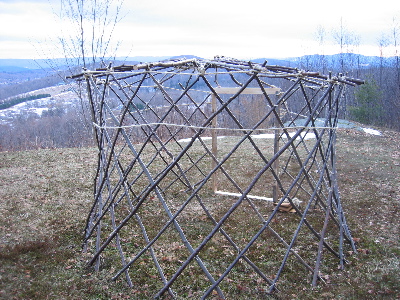Behold the Power of String
|
I got interested in gers about ten minutes before I first landed in Mongolia. As the plane descended to the Ulaanbaatar airport, I saw green hills dotted with white. The little dots were sheep - the big dots were gers. Gers are circular houses, lived in by many Mongolians and by some other central Asians. They're portable, lightweight, spacious, well insulated and comfortable. While more people know the Russian word "yurt", many Mongolians prefer the word "ger". |

|
| For the last five years, my circle of friends has come to our house in the Berkshires at New Years' to cook, dance, reconnect and play. As many of my friends are engineers, "play" often means "build". In the past, we've built successful trebuchets and massage tables and failed treehouses. This year, I was thinking we might build a ger. The night before the hordes descended on our house, I was sketching ger designs and flipping channels. Just as I was thinking I wished I had more pictures of Mongolian gers, I flipped to Worlds Apart, a new show on National Geographic Channel. A family from St. Louis was living in a rural Mongolian village in their own ger. I took this as a sign. |
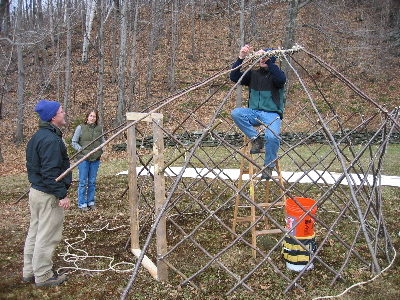
|
| It shouldn't have surprised me that my best friend, Nate (left), was also a ger fan. In the middle of his college career, he'd spent a year backpacking around the former Soviet Union and had fallen in love with the Central Asian republics. As we began building the ger, it became clear we were dealing with different ger paradigms. Nate's paradigmatic ger was a model in a museum in Bishkek. The exhibit was designed to help persuade citizens that it was a good idea to move from primitive, hide-lashed tents into anonymous concrete apartment blocks. |

|
| My paradigmatic ger, on the other hand, is ger #16 (above) at the Hotel Ulaanbaatar #2 in Terelj, a national park in Central Mongolia. In Mongolia on a project for USAID, my business partner and I took a weekend in Terelj, fording streams, hiking hillsides and eating far too much mutton. We shared a lovely, colorful and comfortable ger. It was furnished with two beds, a TV, tables, a wardrobe, a vanity and a woodstove. The TV got a single channel, which largely showed a game show where senior officers competed to sing the lyrics of military ballads. I enjoyed my stay enough that I looked into bringing a ger back to the US, but was thwarted by shipping costs. |
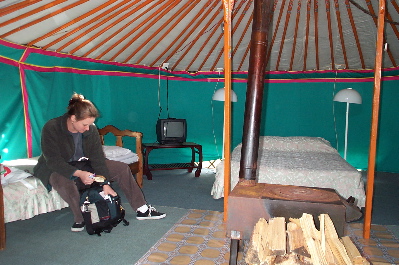
|
| Based on my ger experiences, I wanted to build something that could serve as a spare bedroom for our house. (Invite 50 people to your house for a long weekend and you, too, will want an additional spare bedroom.) Nate wanted to build something using traditional materials, or as close to "traditional materials" as you can get at Home Depot. We compromised. Nate agreed to the purchase of heavy canvas for the roof and walls. (It wasn't much of a compromise, as I paid for the canvas.) I agreed to use non-dimensional lumber for the latticework and roof posts, though reserved the right to use 2x4's for the doorframe. And we agreed that sisal twine would look appropriately "organic" as our main fastener material. |

|
| For those who don't speak wood, "non-dimensional lumber" translates roughly as "sticks". In this case, sticks 8 to 10 feet long and less than an inch in diameter. Fortunately, our land is blessed with ample quantities of black birch, which grows fast, thin and tall. (The trees above aren't black birch. They're sugar maples. But they're on our land, and they're quite striking, don't you think?) Our friends sawed down several dozen black birch. We cut the trees to eight-foot lengths and drilled 1/8th inch holes every foot in the poles. Using narrow brass wire, sisal twine, pliers and the strength and patience of numerous friends, we managed to weave a couple dozen poles into a latticework. |
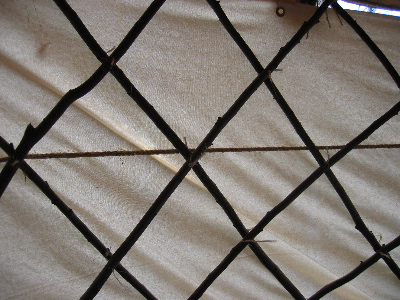
|
| There's a couple of amazing things about the latticework. It's light - 150 square feet of latticework (30 x 5ft) weighs less than 200 pounds. (Anyone who's ever tried to sheetrock 150 square feet of wall understands just how amazing that is.) It's flexible enough to be bent into a 10 foot diameter circle. And it folds into a bundle less than 2 feet in diameter, about 8 feet long. But the amazing thing is that it's held together with string. Really thin, lightweight, easily broken string. But there's strength in numbers. The lattice is held together by at roughly 300 knots, spaced at one-foot intervals. (Should you decide to do this yourself, I strongly recommend NOT using sisal - while it's very pretty, it's hard to thread through the drill holes.) |
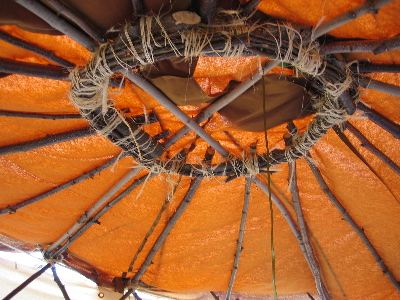
|
| Cutting, drilling and threading trees took the better part of a day. (Keep in mind that there's about eight hours of sunlight in the Berkshires in the dead of winter.) On the second day, we began building a roof. This was the subject of a good deal of debate. My limited experience with Mongolian gers suggested that the roof was pretty difficult to build - the central roof ring and rafters in ger #16 fit together in tight tongue and groove joints. Nate's vision for the roof involved lashing poles to the latticework and to a handcrafted central ring. The result was elegant, and for a brief shining moment, highly pitched. Unfortunately, when we stopped supporting it manually, it corkscrewed down to the point where it was nearly flat. After a good hour's worth of staring, and good advice from our friend Susan (who builds stage props for a living), Nate fixed the roof with two twelve foot poles that covered the entire diameter of the ger and supported the roof. |

|
| Without walls, a ger looks a lot like an abstract sculture, something that Martin Puryear might create on a particularly whimsical day. Our friend Emily, a stage seamstress, grommeted, sewed and wrestled 35 square yards of cotton duck into walls and a roof. (Should you try to do this yourself, she recommends a hexagonal cone for the roof...) With the frame up, the roof and walls went up in less than five minutes. Add an additional ten minutes to put tarps on the ground and a layer of blankets on the tarp, and our ger goes up in about 20 minutes with two people. |
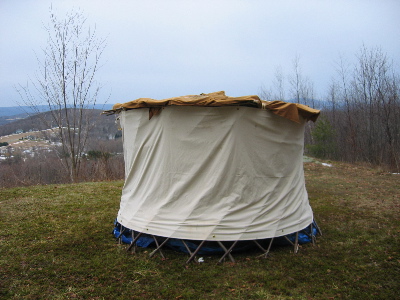
|
| If you look at the bottom of the ger, it's pretty clear that the canvas doesn't quite cover the lattice. This could be a feature or a bug. In the heat of a Mongolian summer, there would be nice airflow from the base, through the interior and out through the smoke hole. In the midst of a Berkshire winter, it seemed wise to tack up layers of tarps and flannel sheets to block the draft. After covering the floor with tarps, old blankets and quilts, it seemed like a good idea to fill the ger with people. Lots of people. Sitting on the floor, we fit about fifteen people in a space ten feet in diameter. But while it was easy to get folks to visit, I worried it might prove more difficult to get folks to stay the night. |
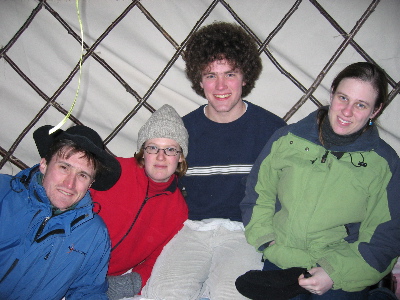
|
| It wasn't. Once we rounded sleeping bags, we found eight hearty folks willing to spend the night. We packed six abreast along the center of the ger, put our smallest friend above our heads and our youngest at our feet, in front of the door. I assumed we'd make it a few hours and wake shivering at dawn to drink coffee and take hot showers. Around dawn, I heard the sound of snow brushing against canvas. An hour or so later, there was a pyramid of snow a foot high on Allegra's sleeping bag - Amy was eating a handful of it, reading a book. When I woke again, it was eleven in the morning and the rest of my compatriots were still snoring. The miracle of the ger - it was the best sleep I got the whole weekend. -Ethan Zuckerman, 1/8/2004 |

|
|
in contentious harmony they work together -Chris Warren |
